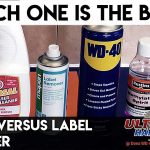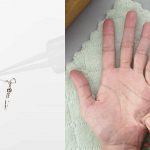Fixing or crafting often requires finding the perfect adhesive. But can super glue really do the trick when it comes to bonding fabric to plastic? Well, you’ve come to the right place. Today, we’re diving into this burning question and shedding light on whether super glue is up to the challenge.
Super glue, also known as cyanoacrylate adhesive, is famous for its lightning-fast bonding abilities. However, its compatibility with different materials can vary. Join us as we explore whether this adhesive lives up to its reputation when faced with the tricky combination of fabric and plastic.
When attempting to bond fabric to plastic, cleanliness is key. Make sure both surfaces are free from any grease or debris. The general process involves applying a small amount of glue along the desired area and firmly pressing the fabric onto the plastic. However, success depends on factors like fabric type, plastic type, and applied stress on the bond.
Stay tuned as we delve into super glue’s compatibility and reliability for fabric-to-plastic bonding. We’ll discuss common challenges and share tips and tricks for achieving optimal results. Whether you’re working on a DIY project or fixing everyday items, this post will equip you with the knowledge needed to make an informed decision when reaching for that tube of super glue.
So let’s uncover the truth about whether super glue passes the test as a fabric-to-plastic bonding agent. Get ready to discover secrets that will help you achieve a secure and durable bond capable of withstanding the test of time.

Types of Fabrics and Plastics Suitable for Super Glue
Contents
- 1 Types of Fabrics and Plastics Suitable for Super Glue
- 2 Preparing Surfaces for Super Glue Application
- 3 Applying Super Glue to Fabric and Plastic
- 4 Curing Time for Bonded Areas
- 5 Advantages of Using Super Glue on Fabric and Plastic
- 6 Disadvantages of Using Super Glue on Fabric and Plastic
- 7 Alternatives to Super Glue for Bonding Fabric to Plastic
- 8 Tips for Successfully Using Super Glue on Fabrics and Plastics
- 9 Conclusion
Super glue, also known as cyanoacrylate adhesive, is a powerful tool for bonding various materials together. But when it comes to fabric and plastic, not all types are created equal. In this article, we’ll explore the characteristics of fabrics and plastics that make them suitable for super glue, helping you choose the perfect pair for your projects.
Synthetic Wonders:
Fabrics with tight weaves and synthetic fibers, such as polyester or nylon, are a match made in adhesive heaven. These fabrics offer a smooth surface that allows super glue to adhere better, resulting in a stronger bond. Their resistance to moisture absorption ensures that the glue can do its job effectively.
When using super glue on synthetic fabrics, you’ll experience the joy of a seamless bond that can withstand tension and movement. Polyester, known for its durability and resistance to wrinkles, provides a reliable canvas for super glue. Nylon, on the other hand, known for its strength and elasticity, creates a bond that can withstand stretching and bending without breaking.
Natural Challenges:
While natural fibers like cotton, wool, or linen may be cozy to wear, they present challenges when it comes to super glue bonding. Their porous nature quickly absorbs the glue, making it less effective in creating a lasting bond. However, if the fabric has a tight weave or is reinforced with another material, it may still be compatible with super glue.
Cotton fabrics with a tight weave can provide a decent surface for super glue bonding. However, it’s essential to be cautious as cotton has a tendency to shrink when exposed to moisture. Wool fabrics can be trickier due to their coarse texture and high absorbency, but if treated carefully and combined with a tight weave backing fabric, they can still form a strong bond. Linen fabrics are typically more challenging to bond with super glue due to their loose and textured weave, but individual testings may reveal compatibility.
Testing is Key:
To avoid any unexpected surprises, always test super glue on a small and inconspicuous area of the fabric before fully committing. Delicate or light-colored fabrics may experience visible residue or discoloration, so it’s best to play it safe. The test will help you assess the compatibility of the fabric with super glue and determine if any modifications or alternative adhesives are required.
Rigid Delights:
When it comes to plastics, rigid options like polystyrene or acrylic are a dream come true for super glue bonding. Their smooth surfaces provide an ideal canvas for the adhesive to form a strong and durable bond. No warping or distortion here.
Polystyrene, commonly used in toy manufacturing and packaging, offers a high surface energy that promotes excellent adhesion with super glue. Acrylic, known for its transparency and versatility, provides a reliable surface for bonding.
Preparing Surfaces for Super Glue Application

Super glue, also known as cyanoacrylate adhesive, is a versatile and popular choice for bonding various materials together, such as fabric and plastic. However, to achieve a strong and durable bond, it is essential to properly prepare the surfaces before applying super glue. Let’s explore the step-by-step process of preparing surfaces for super glue application:
- Thoroughly clean the surfaces: Dirt, dust, or oil on the surfaces can hinder the adhesive’s ability to bond effectively. Use a mild detergent or soap and water to clean both the fabric and plastic surfaces. Rinse them thoroughly and ensure they are completely dry before proceeding.
- Remove stubborn stains or residues: If soap and water are not enough to remove stains or residues on the surfaces, consider using a solvent like rubbing alcohol or acetone. These solvents can effectively eliminate stubborn stains or residues.
- Create a rough texture on the plastic surface: After cleaning the surfaces, it is recommended to slightly roughen up the plastic surface. Use fine-grit sandpaper or an abrasive pad to gently sand the plastic in a circular motion. This process creates a rough texture that provides more surface area for the adhesive to bond to, enhancing its effectiveness. Take care not to oversand the plastic surface, as excessive roughening can weaken the material’s integrity. It is advisable to test a small inconspicuous area first before proceeding with the entire surface.
- Lightly sand glossy or slick fabric surfaces: While fabric surfaces do not require roughening like plastic, glossy or slick finishes can benefit from light sanding. This step enhances the bond between the fabric and adhesive.
- Ensure complete dryness: Before applying super glue, make sure both surfaces are completely dry. Moisture can interfere with the adhesive’s bonding process, so it is crucial to wait until both surfaces are dry to touch.
- Apply super glue sparingly: Use super glue sparingly when applying it to the surfaces. A small amount is usually sufficient for a strong bond. Apply the glue to one surface, then press the fabric and plastic together firmly. Hold the two surfaces in place for a few minutes to allow the adhesive to set properly.
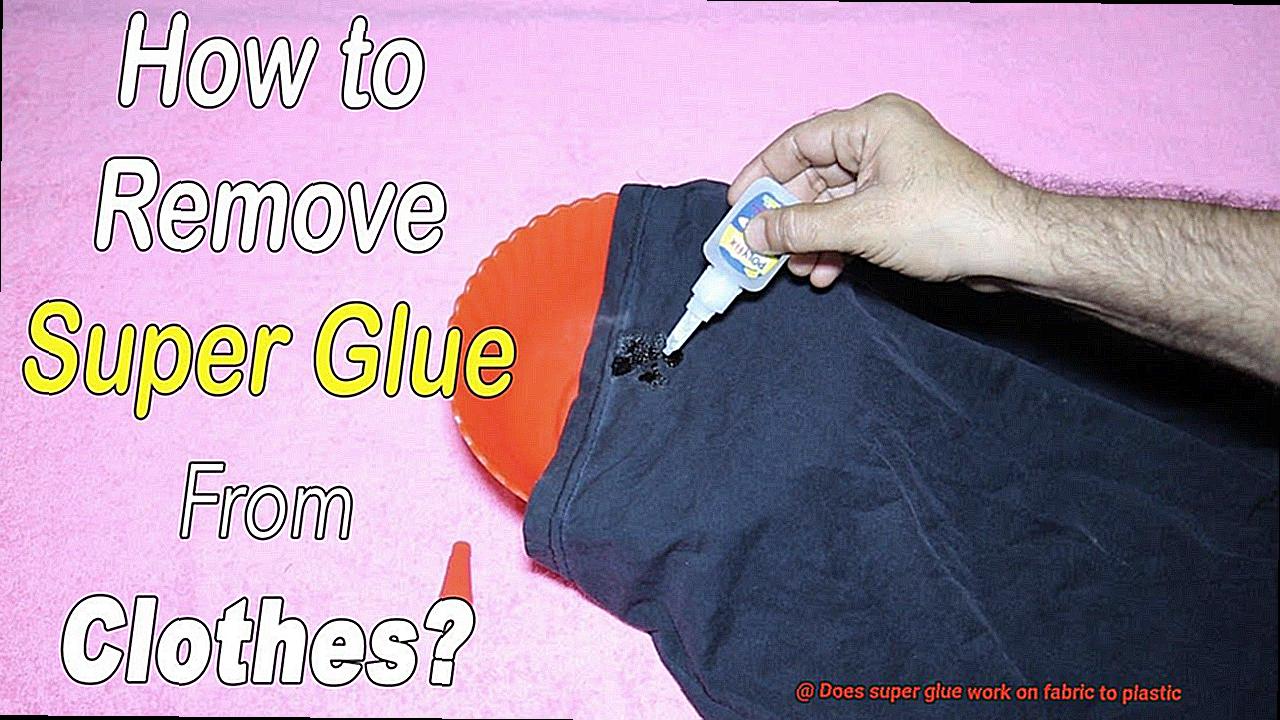
It is important to note that super glue may not be suitable for all fabric and plastic combinations. Certain fabrics, such as silk or satin, may not bond well with super glue. Similarly, some plastics, like polyethylene or polypropylene, have low surface energy and may require specialized adhesives designed for those materials.
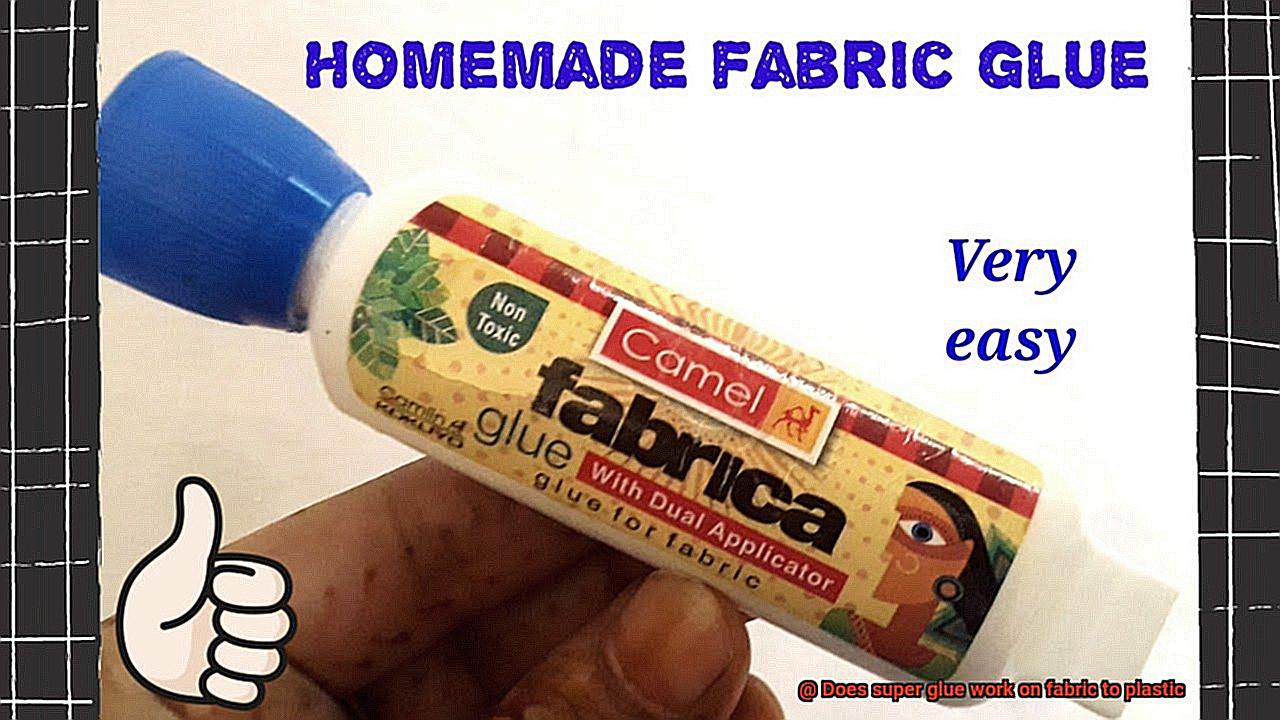
To ensure compatibility and determine the adhesive’s effectiveness, always test the bond strength on a small, inconspicuous area before applying super glue to the entire fabric and plastic surfaces. If super glue does not provide a satisfactory bond, consider exploring other adhesive options specifically designed for these materials.
Applying Super Glue to Fabric and Plastic
Today, we embark on a journey to unravel the secrets of applying this mighty adhesive to fabric and plastic. Whether you’re a casual DIY enthusiast or a professional looking to perfect your crafting skills, this comprehensive guide will equip you with the knowledge needed to achieve strong and lasting bonds. So, let’s dive in.
Prep Like a Pro:
Before diving into the sticky world of super glue, it’s crucial to ensure that both fabric and plastic surfaces are clean and free from dirt, dust, or grease. Gently wipe the surfaces with a clean cloth or use a mild detergent solution for stubborn stains or residues.
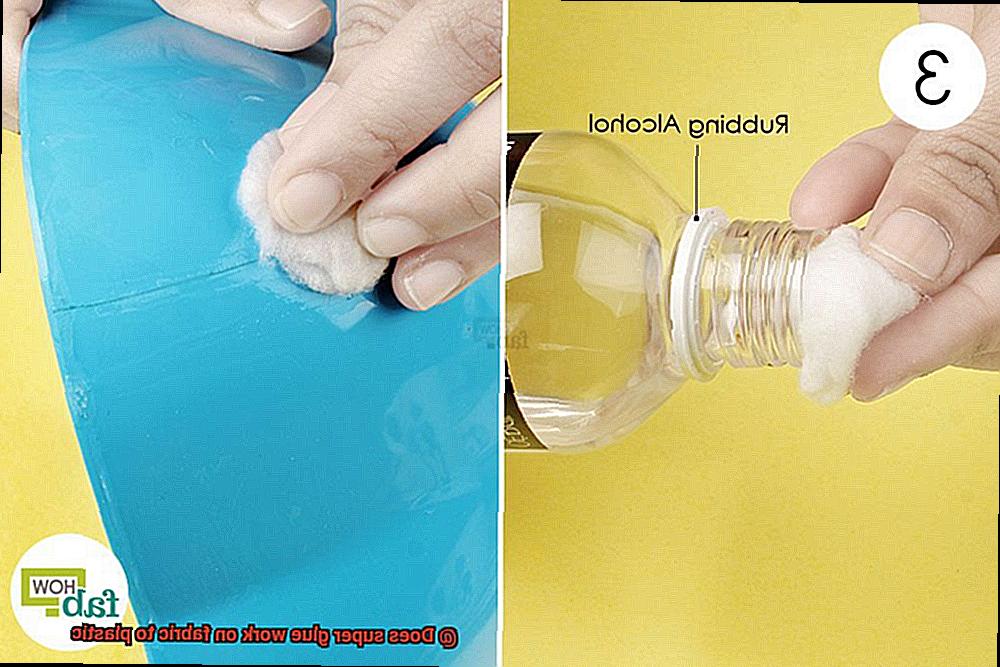
Compatibility Matters:
While super glue works wonders on various materials, it’s important to note that not all fabrics and plastics are created equal. Smooth fabrics like silk or nylon may pose a challenge due to their sleek surfaces. Similarly, certain plastics, such as polyethylene or polypropylene, may resist the adhesive’s charms. Always test a small area first before committing to the entire surface.
Fabric Bonding:
To apply super glue to fabric, start by applying a small amount onto one surface. Then, firmly press the two fabric pieces together. For added strength, roughening glossy fabric surfaces with sandpaper can enhance the bond. Remember to hold the pieces together for a few minutes to allow the glue to work its magic.
Tackling Tricky Plastics:
When it comes to plastic bonding, tread with caution. Test a small area first before proceeding. If super glue doesn’t bond well with the plastic in question, consider exploring adhesives specifically designed for plastic materials. In some cases, creating small scratches or roughening the plastic surface with sandpaper can improve bonding strength – but be mindful that this method isn’t suitable for all plastics.
Patience is Key:
After applying super glue, give it ample time to dry and cure. While it usually takes a few hours, factors like temperature and humidity can influence drying times. Resist the urge to test the bond prematurely – remember, patience is a virtue.
Oops. Accidental Spills:
In the event of an accidental spill or excess glue, act swiftly. Use acetone or nail polish remover to remove the glue from fabric or plastic surfaces. However, always test these solvents on a small, inconspicuous area first to ensure they won’t cause damage.
Curing Time for Bonded Areas
Well, buckle up, because we’re about to dive into the world of super glue and its curing time when bonding fabric to plastic. Whether you’re working on a DIY project or repairing a favorite fabric item, understanding the curing time of your adhesive is crucial for achieving a strong and durable bond.
First things first, let’s talk about the glue itself. Super glue, also known as cyanoacrylate adhesive, is a popular choice for bonding fabric to plastic due to its fast-drying nature and strong bond. It’s readily available in most hardware stores and comes in various viscosities to suit different project requirements.
Now, when it comes to curing time, there are a few factors to consider:
- Type of Super Glue: Different brands and formulations may have specific curing times specified by the manufacturer. It’s essential to read and follow the instructions provided on the product packaging for optimal results.
- Quick Curing Time: In general, most super glues have a relatively quick curing time, ranging from a few seconds to a few minutes. However, it’s important to note that while the initial bond may occur quickly, it may take several hours or even up to 24 hours for the adhesive to fully cure and reach its maximum strength.
- Exercise Caution: During the crucial curing period, it’s essential to avoid putting excessive stress or pressure on the bonded area. This will allow the adhesive to fully set and strengthen. After all, we want that fabric-to-plastic bond to last.
- Environmental Factors: Environmental conditions can also impact the curing time. Warmer temperatures generally result in faster curing times, while colder temperatures may slow down the process. Additionally, high humidity levels can prolong the curing time as moisture in the air can interfere with the bonding process.
So, it’s best to work in a well-ventilated area with moderate temperature and humidity levels for optimal results. Trust me, your fabric and plastic will thank you for it.
Now that you’re equipped with the knowledge of super glue and its curing time when bonding fabric to plastic, you can confidently tackle your next project. Just remember to follow the instructions, exercise patience during drying and curing, and create a bond that will withstand the test of time.
Advantages of Using Super Glue on Fabric and Plastic
Super glue has emerged as a superhero in the adhesive world, offering a myriad of advantages for repairing fabric and plastic items. With its strong bond, quick-drying time, versatility, water resistance, transparent finish, and ease of use, super glue has become the go-to solution for DIY enthusiasts and professionals alike. In this article, we will explore the numerous advantages of using super glue on fabric and plastic, highlighting why it is the ultimate tool for efficient and durable repairs.
Unbreakable Bond:
Super glue lives up to its name by creating an incredibly strong and durable bond. It excels at repairing torn or damaged fabrics and plastics, withstanding stress and pulling with ease. Whether it’s fixing a ripped pair of jeans or mending a broken plastic toy, super glue has got you covered with its unbreakable bond.
Lightning-Fast Drying Time:
In our fast-paced world, time is of the essence. Fortunately, super glue understands the need for speed. Unlike other adhesives that require hours or even days to set, super glue bonds within seconds. This means you can swiftly fix your fabric or plastic items without wasting precious time waiting for the adhesive to dry.
Master of Versatility:
Super glue is a true jack-of-all-trades when it comes to bonding fabrics and plastics. It works wonders on various materials such as cotton, denim, nylon, polyester, acrylic, PVC, ABS, and more. Whether you’re repairing clothing or fixing household items, super glue has the versatility to handle any task that comes its way.
Defying Water:
Life is full of unexpected encounters with water and moisture. Thankfully, super glue is up to the challenge. Once fully cured, it exhibits excellent water-resistant properties. This makes it an ideal choice for repairing fabric items that may come into contact with water or damp environments, ensuring that your repairs stand the test of time.
Invisible Repairs:
Super glue not only fixes your fabric and plastic items but also leaves behind a seamless finish. When dry, it forms a transparent bond that is nearly invisible to the naked eye. This is particularly advantageous when working with intricate patterns or designs, as it ensures that the repaired item maintains its original aesthetic appeal without any unsightly marks or residue.
User-Friendly Hero:
Even superheroes need to be user-friendly, and super glue is no exception. With its precision applicators and controlled application, using super glue is a breeze. A little goes a long way, allowing you to make multiple repairs with just one bottle. This makes it both cost-effective and accessible for professionals and DIY enthusiasts alike.
Disadvantages of Using Super Glue on Fabric and Plastic
While it may seem like a magical adhesive solution, there are several drawbacks that you need to be aware of before using it. So, let’s roll up our sleeves and explore the less-than-ideal side of super glue.
Porous Fabrics: A Sticky Situation
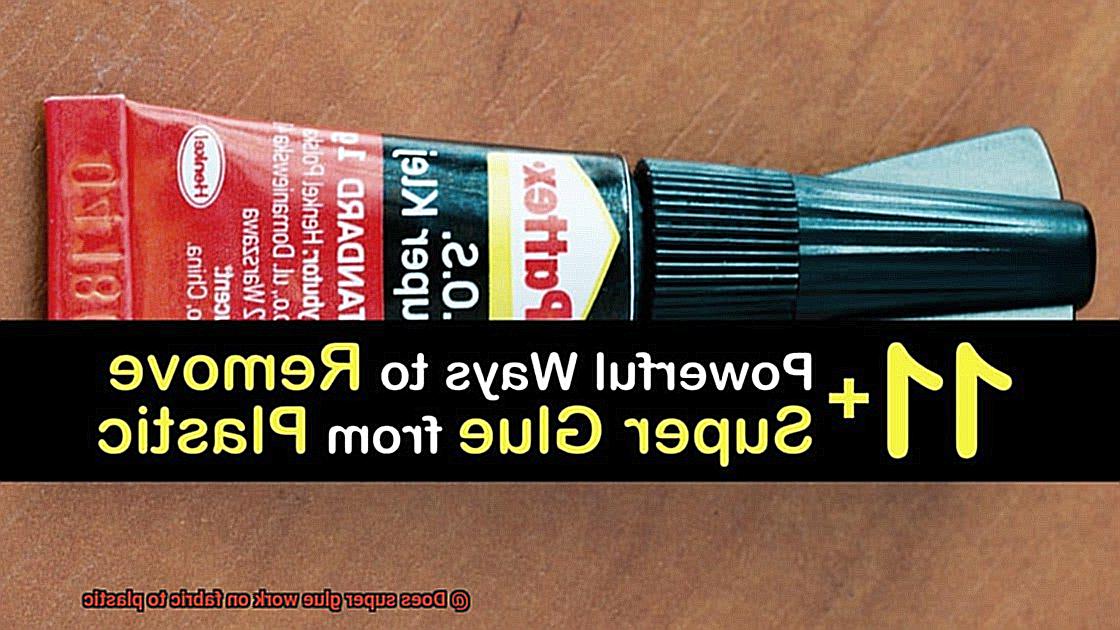
Not all fabrics are created equal, and some can pose significant challenges when it comes to using super glue. Fabrics with loose weaves or a porous nature can absorb the glue, creating a messy appearance or even damaging the material itself. Before bonding, it’s crucial to test the glue on a small, inconspicuous area of the fabric to ensure compatibility.
Residue Remorse: A Sticky Aftermath
Have you ever experienced the frustration of removing sticky residue after using super glue? When applied incorrectly or in excess, super glue can leave behind a visible mark on fabric. Removing this residue can be a daunting task that requires special cleaning methods or solvents, which may further damage the fabric.
Plastic Predicaments: A Brittle Bond
While plastic may seem like an ideal match for super glue, certain plastics can react negatively to its chemicals. This can result in brittleness and cracking, compromising the structural integrity of the material. It is crucial to check the compatibility of the glue with the specific type of plastic before attempting any bonding.
Bonding Boundaries: A Temporary Fix
Super glue may be effective for quick fixes and small repairs, but it may not provide a strong enough bond for long-lasting projects involving fabric and plastic. Heavy-duty applications require specialized adhesives that are specifically designed for bonding these materials together. Choosing the right adhesive is essential to ensure durability and longevity.
No Room for Mistakes: A Precise Affair
In the world of gluing, precision is key. Unfortunately, super glue does not offer much room for error once it is applied. With its instant setting time, there is little opportunity for repositioning or adjustment. This can be problematic when working with delicate materials or trying to achieve precise alignment.
Safety First: A Breath of Fresh Air
Last but not least, let’s talk about safety. Super glue is notorious for its strong fumes, which can irritate the eyes, nose, and throat. It is imperative to use super glue in a well-ventilated area and take necessary precautions to avoid inhalation of the fumes. Protecting your health should always be a top priority.
Alternatives to Super Glue for Bonding Fabric to Plastic

While super glue is a popular choice, there are several alternatives that can provide effective and durable bonds. Let’s explore some options, shall we?
First up, we have fabric glue. This specially formulated adhesive is designed specifically for bonding fabric to various materials, including plastic. It creates a strong and flexible bond that can withstand daily wear and tear. Plus, it dries clear and remains soft, so it won’t stiffen your fabric or affect its flexibility.
Next on our list is hot glue. This trusty adhesive is commonly used in crafts and DIY projects, and it can also work wonders for bonding fabric to plastic. Hot glue provides a strong bond and is quick and easy to apply. Just be cautious of the high temperature, as it can potentially damage certain types of fabric or plastic. Always test a small area first before committing to the entire bond.
If you’re looking for a temporary solution, double-sided adhesive tape might be your best bet. This tape has adhesive on both sides and can easily be applied between the fabric and plastic surfaces. It provides a strong bond that can be removed or repositioned if needed.
For the crafty folks out there, sewing can be a great alternative for bonding fabric to plastic. Using a sewing machine or hand-stitching, you can create seams or stitches that securely hold the fabric to the plastic surface. This method allows for flexibility and durability, making it suitable for various projects.
Last but not least, there are specialized adhesives available that are specifically designed for bonding fabric to plastic. These adhesives are formulated to create a strong and durable bond that can withstand regular use. Just make sure to choose one that is suitable for your specific fabric and plastic materials.
Tips for Successfully Using Super Glue on Fabrics and Plastics
Super glue is a versatile adhesive that can be used to bond fabrics and plastics together. However, achieving a successful bond requires following some key tips. In this guide, we will explore the best practices for using super glue on fabrics and plastics, from preparing the surfaces to allowing proper drying time. Let’s dive in.
Prepare the Surfaces:
To ensure a strong bond, it is crucial to clean and dry both the fabric and plastic surfaces before applying super glue. Wipe away any dirt, dust, or grease with a clean cloth or mild detergent. This step not only enhances adhesion but also eliminates potential contaminants that could compromise the bond.
Choose the Right Type of Super Glue:
Not all super glues are created equal when it comes to bonding fabrics and plastics. Look for a super glue specifically designed for these materials. Check the packaging or consult a knowledgeable salesperson to find the best product for your needs. Using the right type of glue will enhance the bond and ensure long-lasting results.
Apply Glue Sparingly:
Remember, less is more when it comes to super glue. Apply a thin layer of glue on one surface only. Press the two surfaces together firmly, ensuring even distribution of pressure across the bonded area. Avoid applying too much glue as it can overflow and create a mess. A little bit of glue goes a long way.
Allow Proper Drying and Curing Time:
After bonding the fabric and plastic, patience is key. Follow the manufacturer’s instructions for recommended drying time. Factors like humidity and temperature can affect drying speed, so adjust accordingly. Rushing this step may compromise the bond’s strength, so give it ample time to set properly.
Use Clamps or Weights if Necessary:
For larger pieces or uneven surfaces, consider using clamps or weights to apply steady pressure during the drying process. This technique ensures better contact between the fabric and plastic, leading to a stronger bond. Strategically position the clamps or weights to evenly distribute pressure across the bonded area.
Conclusion
Super glue is a versatile adhesive that can bond various materials together, including fabric and plastic. When it comes to joining these two surfaces, super glue can be an effective solution. Its strong and fast-drying formula ensures a secure bond between the fabric and plastic, creating a durable connection that withstands everyday wear and tear.
But let’s not forget about the importance of proper application. Before applying super glue, it’s crucial to clean and prepare both the fabric and plastic surfaces. This ensures optimal adhesion and prevents any unwanted debris or residue from interfering with the bond.
Once you’ve prepped the surfaces, simply apply a small amount of super glue to one side and press the fabric firmly against the plastic. Hold them together for a few moments to allow the adhesive to set. And voila. You’ve successfully united fabric and plastic in a seamless union.
Whether you’re repairing a torn upholstery or creating a DIY project that combines different materials, super glue proves its effectiveness time and time again. Its ability to bond fabric to plastic opens up endless possibilities for creativity and functionality.
So, next time you find yourself wondering if super glue works on fabric to plastic, rest assured that this trusty adhesive will come through for you. With its reliable strength and easy application process, super glue is your go-to solution for joining these two materials with confidence.
In conclusion, yes, super glue does work on fabric to plastic. It provides a strong bond that withstands daily use while offering versatility for various projects.





